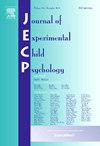Examining the relationship between psychosocial adversity and inhibitory control: A functional magnetic resonance imaging study of children growing up in extreme poverty
IF 1.8
2区 心理学
Q3 PSYCHOLOGY, DEVELOPMENTAL
引用次数: 0
Abstract
Exposure to psychosocial adversity (PA) is associated with poor behavioral, physical, and mental health outcomes in adulthood. As these outcomes are related to alterations in developmental processes, growing evidence suggests that deficits in executive functions—inhibitory control in particular—may in part explain this relationship. However, literature examining the development of inhibitory control has been based on children in higher-resource environments, and little is known how low-resource settings might exacerbate the link between inhibitory control and health outcomes. In this context, we collected functional magnetic resonance imaging data during a Go/No-Go inhibitory control task and PA variables for 68 children aged 5 to 7 years living in Dhaka, Bangladesh, an area with a high prevalence of PA. The children’s mothers completed behavioral questionnaires to assess the children’s PA and their own PA. Whole-brain activation underlying inhibitory control was examined using the No-Go versus Go contrast, and associations with PA variables were assessed using whole-brain regressions. Childhood neglect was associated with weaker activation in the right posterior cingulate, whereas greater family conflict, economic stress, and maternal PA factors were associated with greater activation in the left medial frontal gyrus, right superior and middle frontal gyri, and left cingulate gyrus. These data suggest that neural networks supporting inhibitory control processes may vary as a function of exposure to different types of PA, particularly between those related to threat and deprivation. Furthermore, increased activation in children with greater PA may serve as a compensatory mechanism, allowing them to maintain similar behavioral task performance.
研究社会心理逆境与抑制控制之间的关系:针对赤贫儿童的功能磁共振成像研究
暴露于社会心理逆境(PA)与成年后不良的行为、身体和心理健康结果有关。由于这些结果与发育过程的改变有关,越来越多的证据表明,执行功能--尤其是抑制控制--的缺陷可能在一定程度上解释了这种关系。然而,研究抑制控制能力发展的文献都是基于高资源环境中的儿童,而对于低资源环境如何加剧抑制控制能力与健康结果之间的联系却知之甚少。在这种情况下,我们收集了生活在孟加拉国达卡的 68 名 5 至 7 岁儿童在进行 Go/No-Go 抑制控制任务时的功能磁共振成像数据和 PA 变量。这些儿童的母亲填写了行为问卷,以评估儿童的PA和她们自己的PA。使用 "不走 "与 "走 "对比法检测了抑制控制的全脑激活情况,并使用全脑回归法评估了与 PA 变量的关联。童年被忽视与右侧扣带回后部较弱的激活有关,而更大的家庭冲突、经济压力和母亲PA因素则与左侧额叶内侧回、右侧额叶上部和中部回以及左侧扣带回更强的激活有关。这些数据表明,支持抑制控制过程的神经网络可能会因暴露于不同类型的 PA 而变化,尤其是在与威胁和剥夺相关的 PA 之间。此外,PA 较高的儿童的激活增加可能是一种补偿机制,使他们能够保持类似的行为任务表现。
本文章由计算机程序翻译,如有差异,请以英文原文为准。
求助全文
约1分钟内获得全文
求助全文
来源期刊

Journal of Experimental Child Psychology
Multiple-
CiteScore
4.50
自引率
7.70%
发文量
190
期刊介绍:
The Journal of Experimental Child Psychology is an excellent source of information concerning all aspects of the development of children. It includes empirical psychological research on cognitive, social/emotional, and physical development. In addition, the journal periodically publishes Special Topic issues.
 求助内容:
求助内容: 应助结果提醒方式:
应助结果提醒方式:


